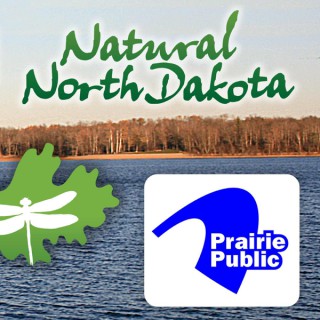Dakota Datebook
Follow Dakota DatebookStories of things that happened in North Dakota and vicinity. Sitting Bull to Phil Jackson, cattle to prairie dogs, knoefla to lefse. In partnership with the Historical Society of North Dakota, and funded by the North Dakota Humanities Council, a nonprofit, independent state partner of the National…
- Dec 6, 2025 LATEST EPISODE
- weekdays NEW EPISODES
- 2m AVG DURATION
- 1,423 EPISODES
More podcasts from Prairie Public
Latest episodes from Dakota Datebook

Long before weather alerts or five-day forecasts, people watched the animals, listened to the winds, took note of the moon and stars, and told tales to predict the weather.

In the late 1800s, workers averaged ten to sixteen hours a day, six days a week. Workers in Great Britain and the United States began to push for a reduction in work hours.

On the morning of July 30, 1916, New York City was jarred awake by a huge explosion. Four people were killed, thousands of windows were blown out, and the Statue of Liberty was hit with debris.

Old Wild Rice is the “George Washington” of the Pembina Band of Chippewa. He was frequently mentioned in the Northwest Company fur trade journals of Charles Jean-Baptiste Chaboillez and his successor, Alexander Henry.

As Secretary of State for President James Monroe, John Quincy Adams advocated for the expansion of the United States. He was responsible for establishing the northern boundary of the country from the Lake of the Woods to the Rocky Mountains, and eventually to the Pacific Ocean. More than any other man, Adams was responsible for putting the Monroe Doctrine into action.

Once there was a man who came to Dakota seeking his fortune. He prospered and proposed marriage to a lady back east. But she hesitated to come to Wahpeton, terrified of tornadoes.

In 1941, poultry were making headlines across North Dakota and the country.

One of North Dakota's most striking beauties has to be frost, the glistening white that covers tree branches, power lines, street signs, even blades of grass. It would take a lifetime to paint even one acre of trees all white, but Jack Frost does it overnight.

In this episode of Dakota Datebook, we'll listen to Mark Bluestone, enrolled member of the Mandan, Hidatsa, Arikara Nation, discuss the importance of feeding people.

On this date in 1896, the Jamestown paper reported Mrs. Swain had been taken home to New Rockford for burial. She and her lover were found dead in a Valley City hotel room. A note left at the scene said, "You will find sufficient funds in my pocketbook to bury us. Our last request is to bury us together without any fuss, and do not try to find out who we are. Parted in life but joined in death."

The Dorcas Society is a charitable organization named after Dorcas, a woman described in the Acts of the Apostles. Dorcas was a biblical figure widely known for her dressmaking abilities. The primary mission of the society was originally to provide clothing for the needy, although that grew to include other necessities, like food.

In the 1870s, there were about 1,700 farms in the territory that became North Dakota, with farms averaging 176 acres in size. By 1910, that number had grown to over 7,000 farms, averaging 382 acres. Wheat emerged as a major crop, and the future looked rosy for farmers.

In November of 1970, billboards began popping up along highways in Montana and South Dakota with bold letters stretching across the landscape: “Go North to Dakota!”

The Commercial Hotel, built before 1878, was among the first few buildings in Wahpeton, and its only hotel before the boomtown years. It was advertised as "first-class in every way," popular with those seeking business opportunities, land claims or a quick Dakota Territory divorce.

The 1910 polio epidemic began in the Northeast and spread across the country. It primarily affected children and caused widespread fear and confusion. There were no reliable treatments, and desperate parents sometimes turned to unproven methods to help their children.

November 19 marks the annual Lydia Pinkham Open Studios event in Lynn, Massachusetts, showcasing artists at the historic factory where Lydia's famous Vegetable Compound for Women was manufactured.

On this date in 1932, a two-day demonstration of Boy Scout activities was held at the Wahpeton Indian School for troops from Richland and Wilkin counties. Physician and author Charles Alexander Eastman, a Sisseton-Wahpeton Dakota, served as an advisor in developing the national Boy Scout movement and its Native American Lore component.

North Dakota tops all other states in the production of several crops, including oats, flaxseed, canola, and peas, and ranks second in sunflowers and wheat. The state usually places between 15th and 20th in national corn production. While corn isn't one of North Dakota's top crops, it's still significant, its annual production is valued at about two billion dollars.

I'm going to share with you a story you probably won't believe, but it's true. Long before Red Bull or Monster, a farmer in North Dakota may have stumbled on the first real “energy drink.”

In 2008, Woodrow Wilson Keeble was posthumously awarded the Congressional Medal of Honor by President George W. Bush for his actions in the Korean War.

Steamboats on the Missouri and Red Rivers once made travel much easier. Of course, the steamboats had to be taken out of the water for the winter but the rivers were still used for travel.

The measles cropped up in North Dakota in 1905. At first, it didn't attract much attention, and there were only small mentions of it. Newspapers reported that “W.S. Dow has been wrestling with the measles this week,” and “H.M. Blazer and family are sick with the measles.” These small incidents were precursors to the main event.

Armistice Day was the name of the holiday we now call Veterans Day until 1954, reflecting the date of the armistice with Germany that ended hostilities in World War I in 1918. The Bismarck Tribune published an extra edition announcing the historic end of the war and how quickly the news spread across North Dakota, with the banner headline: “PEACE.”

Drake, North Dakota, English teacher Bruce Severly did not expect controversy to erupt when he added Kurt Vonnegut's “Slaughterhouse-Five” to the reading list for his class. Most of the students were pleased with the addition, but one student complained about offensive language. That was enough for the school board to order the book removed from the classroom and to direct that all copies be destroyed.

North Dakota has a long history with baseball. It was a cheap and easily-organized form of entertainment for people living on isolated farms and ranches, giving them the chance to gather for a social event. Those early games tended to be a matter of local pride, with neighboring towns competing. When the railroad arrived, teams began traveling. One of the biggest rivalries was between Grand Forks and Fargo.

In this episode of Dakota Datebook: Teachings of Our Elders, we'll listen to Mark Bluestone, enrolled member of the Mandan Hidatsa Arikara Nation, talking about recognizing our veterans.

As European settlers moved onto the Great Plains, they built wooden structures for shelter. These were vulnerable to fires, especially as settlers began building communities with wooden buildings close together. Fire, whether from natural causes like lightning or accidents caused by humans, could destroy an entire town in the blink of an eye.

Mary Ada Fisher was born at Somerset, Ohio, on July 5, 1888, the fourth child of John and Amita Fisher. When Mary was 10 years old, she moved with her family to North Dakota to settle the affairs of a deceased uncle. The Fisher family decided to stay, and bought a homestead near Wolf Creek where John built the Fisher store and post office, which then became known as Fisher, North Dakota.

In the fall of 1910, there was a big scandal in Minot. Citizens wanted to know: who drank the beer?

On this date in 1969, a shocking and grisly crime unfolded in the wee hours of Halloween morning. Various rumors began circulating in Wahpeton, spawning different local legends of the Halloween Horror.

There was a man in Grand Forks named Royal L. Boulter who was an innovator and an inventor. Back in 1896, R.L. “Roy” Boulter secured a patent from the U.S. Patent Office for what he called a “bicycle-boat.”

October is Archives Month, when archives around the country celebrate the records in their holdings and recognize the archivists who assess, collect, organize, preserve, and provide access to information of lasting value. The North Dakota State Archives is part of the State Historical Society of North Dakota.

In 1865, French historian and abolitionist Edouard de Laboulaye proposed a monument to celebrate the upcoming centennial of American independence and the abolition of slavery. The project was delayed by the Franco-Prussian War, but finally got underway in 1875. The plan was for the people of France to fund the statue, while Americans would provide a site and build the pedestal.

Eleanor Maguren never had a teddy bear as a child. Born in 1918 on a farm near Leonard, North Dakota, she became a teacher after college. Around 1945, she bought her first teddy bear in Fargo, adding a few more over the years without much thought.

At 1,875 miles, U.S. Route 281 is the longest continuous north-south U.S. highway, running from the Canadian border in the north to the Mexican border in the south. The northern terminus is at Dunseith, North Dakota, near the International Peace Garden. The highway serves as a vital north-south corridor for both business and leisure travel.

The effort of North Dakota women to win the right to vote began in earnest in the late 19th century and continued to grow. Famed suffragettes like Susan B. Anthony arrived in the state to help organize the movement. British suffragettes also came to offer support and encouragement. In 1912, Sylvia Pankhurst spent time in North Dakota on a lecture tour. She spoke to large and enthusiastic crowds. When she came to Fargo, the newspaper called her “one of the world's most notable women.”

The North Dakota State Archives houses a collection of papers compiled by local WPA workers during the 1930s. These include a variety of interviews and gathered information about people, places, and more, all related to North Dakota.

Early in 1902, the United Mine Workers called for a strike in the anthracite coal fields of eastern Pennsylvania. They demanded safer working conditions and higher wages. The mine owners refused to meet with the union. George F. Baer, leader of the operators, insisted that so-called “labor agitators” did not have the best interests of the miners at heart. He claimed the owners would protect the workers' rights.

Over six decades, Miss Briggs was likely the most frequently mentioned name in the Wahpeton papers. Her advertisements and activities were regular fodder.

During the 1860s, Major General John Pope needed additional troops in the Trans-Mississippi West, but the Union Army was preoccupied with the Civil War. General Ulysses S. Grant sent the only troops he felt he could spare: the 1st U.S. Volunteer Regiment, made up of former Confederate soldiers who had been taken prisoner and were willing to trade their gray uniforms for blue.

When 21-one-year-old Berth Kaepernick talked her way into the bronc riding event at the Cheyenne Frontier Days in 1904, she became the first woman to compete against men at one of the big rodeos.

October is Archives Month, when archives across the country celebrate their records and recognize the archivists who assess, collect, preserve, and provide access to information of lasting value. The North Dakota State Archives is part of the State Historical Society of North Dakota.

















